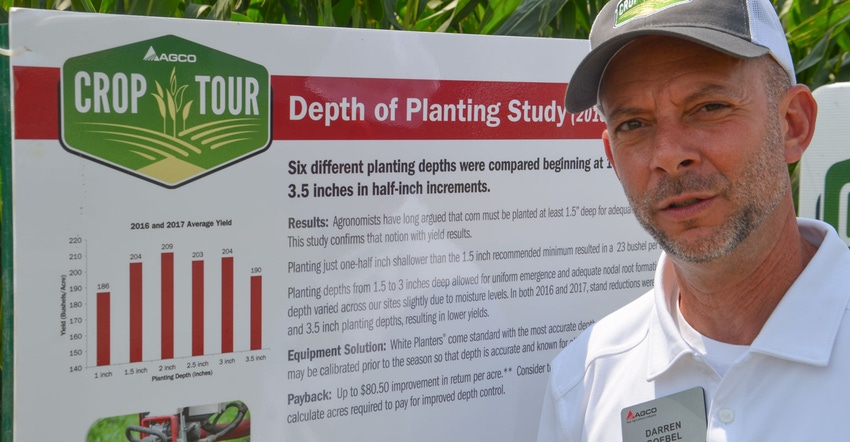
Thoughts in the fall are supposed to be about harvest, right? Darren Goebel thinks fall is a good time to think about planting. Specifically, the director of global agronomy and farm solutions for Agco says it’s the perfect time to evaluate if you made the right choice on planting depth.
Agco conducted field trials at various locations across the Corn Belt, from Ohio to Nebraska. This is the third year for the project. “We wanted to test out principles which we talk about and see if they translated into yield differences,” Goebel says.
One factor they’ve tested each year is planting depth for corn. At the Union City, Ohio, location, one trial in 2018 compared planting at 1, 1.5, 2, 2.5, 3 and 3.5 inches. The 2-inch depth is often considered the sweet spot for planting corn, but some growers raise or lower the depth depending upon moisture conditions.
Shallow vs. deep
Goebel and co-workers did yield estimates before a field day in mid-August. The highest yield at the Union City trial could be in the 2.5-inch planting depth. Yield estimates for respective depths, starting at 1 inch, were 171, 176, 179, 201, 158 and 158 bushels per acre.
“We’ll take these plots to yield, and we’ll also compare them to results from the same trial at other plots and in the past two years,” Goebel says. In previous years, top yields typically came around the 2-inch depth. However, yields for 2.5, 3 and even 3.5 inches in the past two years were reasonably close to yields at the 2 inch-planting depth, he says. Yields for shallower planting depths are often lower.
“We planted into dry soil at the 1-inch planting depth in Ohio this year,” Goebel says. Seed waited for moisture, and the 1-inch planting depth looked good at field day time, although the yield estimate was lower.
Goebel notes that yields for the 3- and 3.5-inch depths are usually closer to yields for the 2- or 2.5-inch depths. It’s possible conditions in this field and weather events resulted in seed winding up even deeper than the intended depth this year.
Late emergers
The whole idea is for seed to emerge as uniformly as possible, Goebel says. That’s more likely when corn is planted into consistent moisture conditions.
“We noted that plants which emerged nearly three days late in these plots were about a leaf collar behind later on,” Goebel says. “If they emerged even later and were two leaf collars behind neighbors, they were basically weeds.”
Other tests through the years have produced similar results. A three-year study by Indiana Prairie Farmer in conjunction with the Tippecanoe County Extension Service and Throckmorton Research Center near Romney, Ind., determined that there was no statistical difference between planting corn at 2, 3 or nearly 4 inches deep. The only difference occurred during the first year of the trial, when corn at 1 inch yielded nearly 20 bushels per acre less. It emerged late and stayed behind all season.
About the Author(s)
You May Also Like




